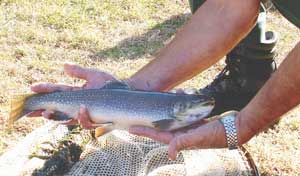
The Nantahala River in Macon and Swain counties is widely known as one of the top white-water paddling streams in the Southeast. Indeed, from early spring to late fall, the challenging white-water rapids through the Nantahala Gorge are crowded with kayakers, rafters, and canoers — amateurs as well as a number of Olympic-class paddlers.The Nantahala also is a first-class trout stream, offering a mix of wild-trout waters in its upper reaches, delayed-harvest fishing in its mid-section, and a mix of healthy stream-raised and stocked trout in its lower portion.
Because of intense white-water activity during the day, the N.C. Wildlife Resources Commission allows night fishing at the Nantahala River downstream from the Swain County line.
Rising in southwestern Macon County near Standing Indian, the Nantahala River flows northwest to the Clay County line, continuing along the boundary of the two counties and on to the Little Tennessee River and Fontana Reservoir. Long before the river reaches Fontana, it forms Nantahala Lake in Macon County.
The upper section of the Nantahala River and its tributaries above the lake are designated as wild-trout waters. The exception is Kimsey Creek at the Standing Indian section of Macon County, one of a handful of streams designated as wild trout/natural bait waters.
Below Standing Indian Campground and continuing to Nantahala Lake, the river is part of the exclusive Rainbow Springs Club and off limits to the public fishing.
Below the Nantahala Lake dam to the mouth of White Oak Creek, the river operates under hatchery-supported waters rules. Unfortunately, the section below the dam gets little water because of a pipeline diverting most of the water to the powerhouse at the head of the Nantahala Gorge. Fishing is marginal at best.
Below White Oak Creek and continuing about 4 miles to the powerhouse, the Nantahala River is designated as delayed-harvest waters. The stream is stocked from March through August, providing plenty of fish for the catch-and-release season and the catch-and-keep season. Below the powerhouse, the stream is hatchery-supported waters.
Ronnie Setzer of Sylva, a long-time trout fisher and former guide, calls the Nantahala River one of the area’s premier trout streams.
“It offers some excellent fishing, and it has some big trout in it, especially in the lower section below the powerhouse,” he said. “It’s a very accessible stream, and much of it can be fished from the banks.”
Anglers who regularly fish the stream have observed the stream has one of the better caddis hatches in the mountains, a hatch that usually extends from mid-May through July.
A No. 14 or 16 yellow-bodied Elk Hair Caddis is an extremely good pattern for the Nantahala, at its delayed-harvest and hatchery-supported sections.
The stream also has abundant hatches of Blue-Winged Olives that can be found about any time of the year. Best fly sizes are Nos. 16 to 20.
The river gets heavy fishing pressure because of its easy access and frequent publicity. During delayed-harvest season weekends, just about every parking pulloff spot is filled with vehicles. Many of the weekend fishers are from South Carolina, Georgia, and outlying areas of North Carolina, especially the Charlotte area.
Recently, George and Debra Williams of Lavonia, Ga., were fishing the delayed-harvest section — she fishing with a spinning rod and he with a fly rod.
“My husband is just learning to fly fish, and this is about the only place he can catch trout,” Debra Williams said.
Jim Borawa of Asheville, WRC fisheries-research coordinator, said a creel survey conducted several years ago showed 48 percent of the fishers at the delayed-harvest section weren’t from North Carolina.
Borawa said the hatchery-supported waters below the powerhouse have a much larger population of wild trout than the delayed-harvest section above the powerhouse because of nutrients coming into the river from Nantahala Lake.
“Also,” he said, “water quality is good enough to support natural reproduction.”
Water levels above the powerhouse are fairly constant, but the water flow below the dam can be erratic, When the turbines are running at the powerhouse, the stream is strictly white-water country as the river’s flow gushes through the gorge. Water levels can rise quickly, and fishers are advised to exit the stream if they notice the river starting to rise.
The Nantahala River produced the state-record brown trout, weighing 24 pounds, 10 ounces, in 1998. Robert Dyer of Sylva caught the big brown with a Rapala lure. However, the big fish wasn’t caught in the main waters but rather came from the powerhouse section, which is off limits to public fishing.
Dyer was able to fish that section because he was an employee of Nantahala Power and Light Co. The brown trout had been feeding on chum created by the powerhouse turbines.
U.S. 19 west of Bryson City parallels the lower section of the Nantahala River from Nantahala Falls to just below the powerhouse. Access to the delayed-harvest section is off U.S. 19 at Wayah Road at the Nantahala River Launch Site Recreation Area. The road at the delayed-harvest section is paved with numerous pull-offs.




Be the first to comment